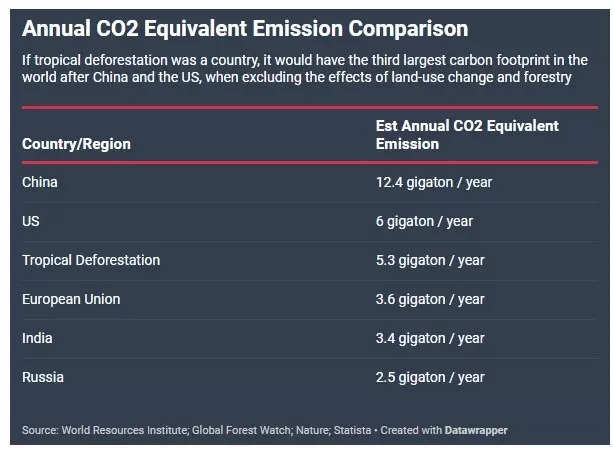While experts and world leaders have been speaking about the need to reduce deforestation Climate change Mitigation strategy, the loss of tree cover has been occurring around the world.
and, data and imagery from global forest watch Analysis in recent research published by the journal Nature earlier this year shows that the loss of tropical tree cover resulted in an average of 5.3 gigatonnes of annual CO2 equivalent emissions between 2001 and 2019.

Analysis by Statista, a global company specializing in data, shows that this average annual CO2 equivalent emissions – due to tropical deforestation – are about 2 gigatonnes higher than India’s estimated annual emissions of 3.4 gigatonnes. The company has also used data from the World Resources Institute.
In fact, if tropical deforestation were a country, it would be the third largest country in the world. Carbon Footprint in the world after China and the US, when excluding the effects of land use change and forestry (see graphic).
The study in Nature, accessed by TOI, has 17 authors/researchers from the US, Netherlands and Indonesia. And, in the conclusion of their study, the authors add: “Our analysis reinforces the need to reduce gross emissions from tropical deforestation as a climate change mitigation strategy, while maintaining substantial but often less frequent, substantial reductions in intact primary and older secondary forests.” uncovers a low contribution to carbon dioxide removal.”
Pointing out that quantifying individual and persistent gross emissions and removals across all forest lands – and creating maps in addition to tabular data – will help in transparency in accounting for factors and geographic regions contributing to global net forest GHG fluxes. It also provides a framework for integrating new and improved data sources over time and governments interested in spatially prioritizing the implementation and tracking of national and subnational forest mitigation goals, he said. Can access data faster.
“Non-government actors, such as companies aiming to reduce emissions from deforestation associated with commodity supply chains and emerging market mechanisms while considering the inclusion of forests for carbon offset programs, can use this to develop globally.” but can benefit from coherent and spatially explicit forest monitoring systems Internationally accepted methods, as used by national governments, but based on independent observations and GHG estimates that can be linked to individual actions and can be generated at a scale relevant to diverse climate-related policies, programs and stakeholders,” the study reads.
He says that as the ability of national governments to collect, process and analyze data continues to improve, the global forest carbon monitoring framework introduced here will enhance transparency, inform forest-related climate policy and implementation initiatives, provide independent Can help in outlining, harmonizing technical assessments. The differences between national reports and scientific studies, and under the forthcoming Global Stocktake 30 of the Paris Agreement provide a more consistent and comparable basis for tracking progress on a local scale and assessing the atmospheric impacts of global forest change.
.